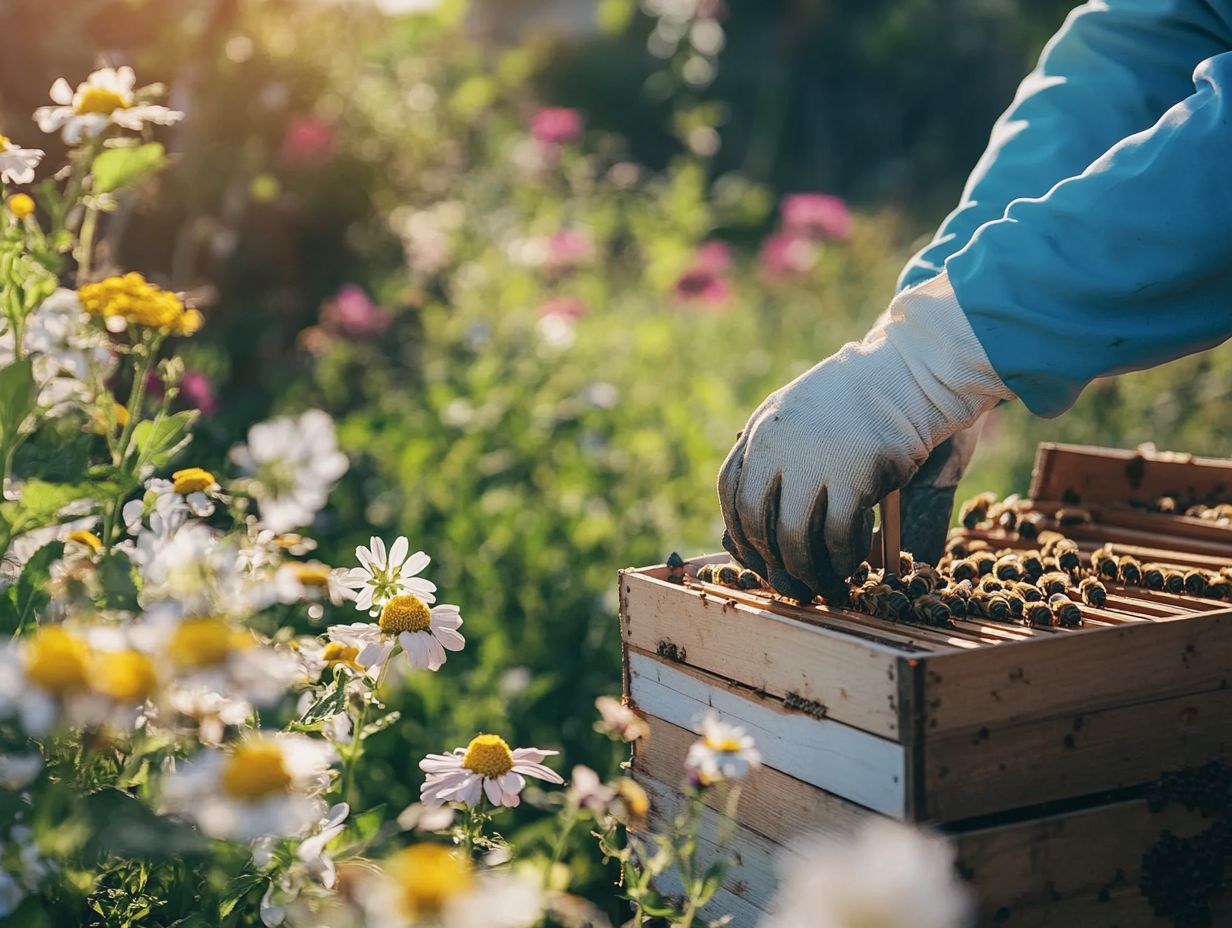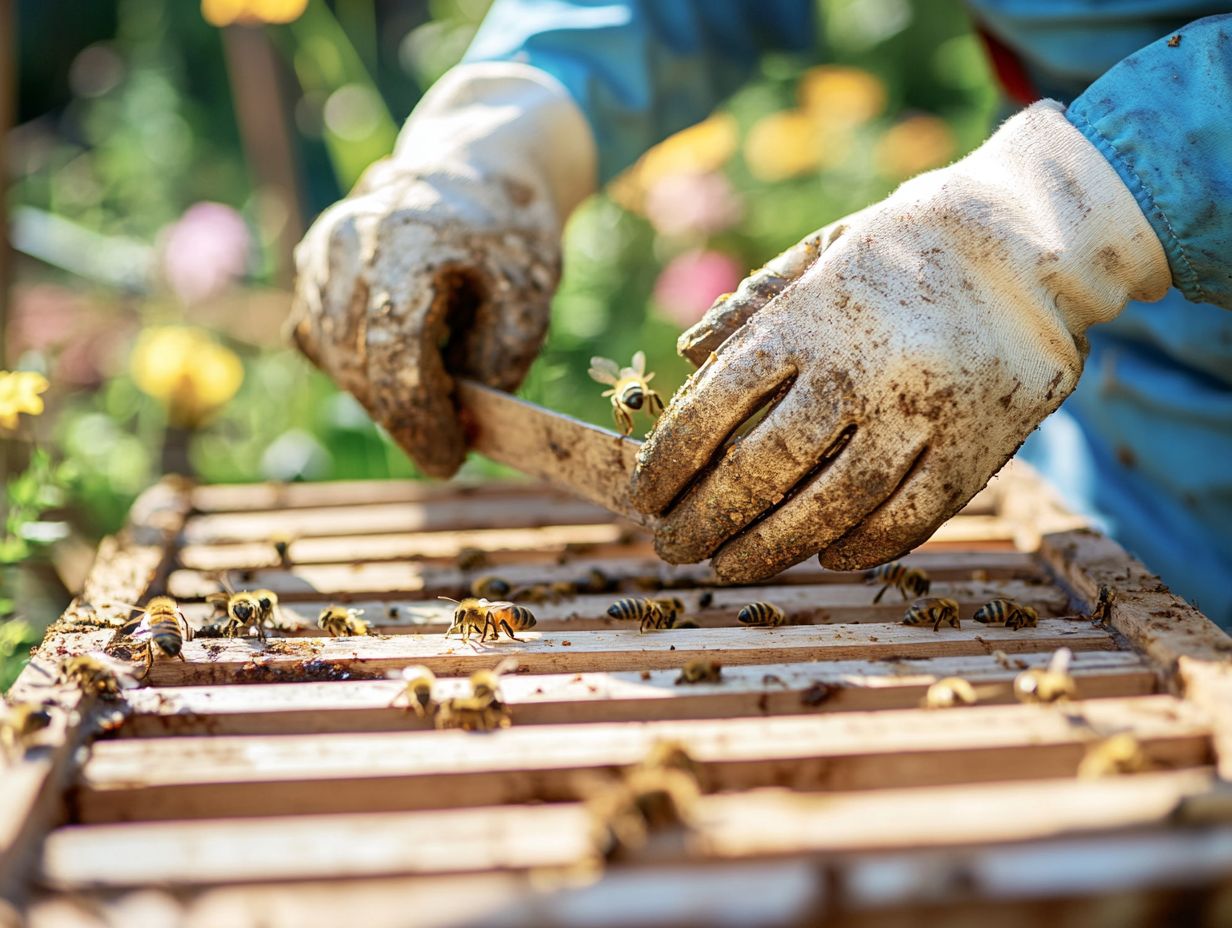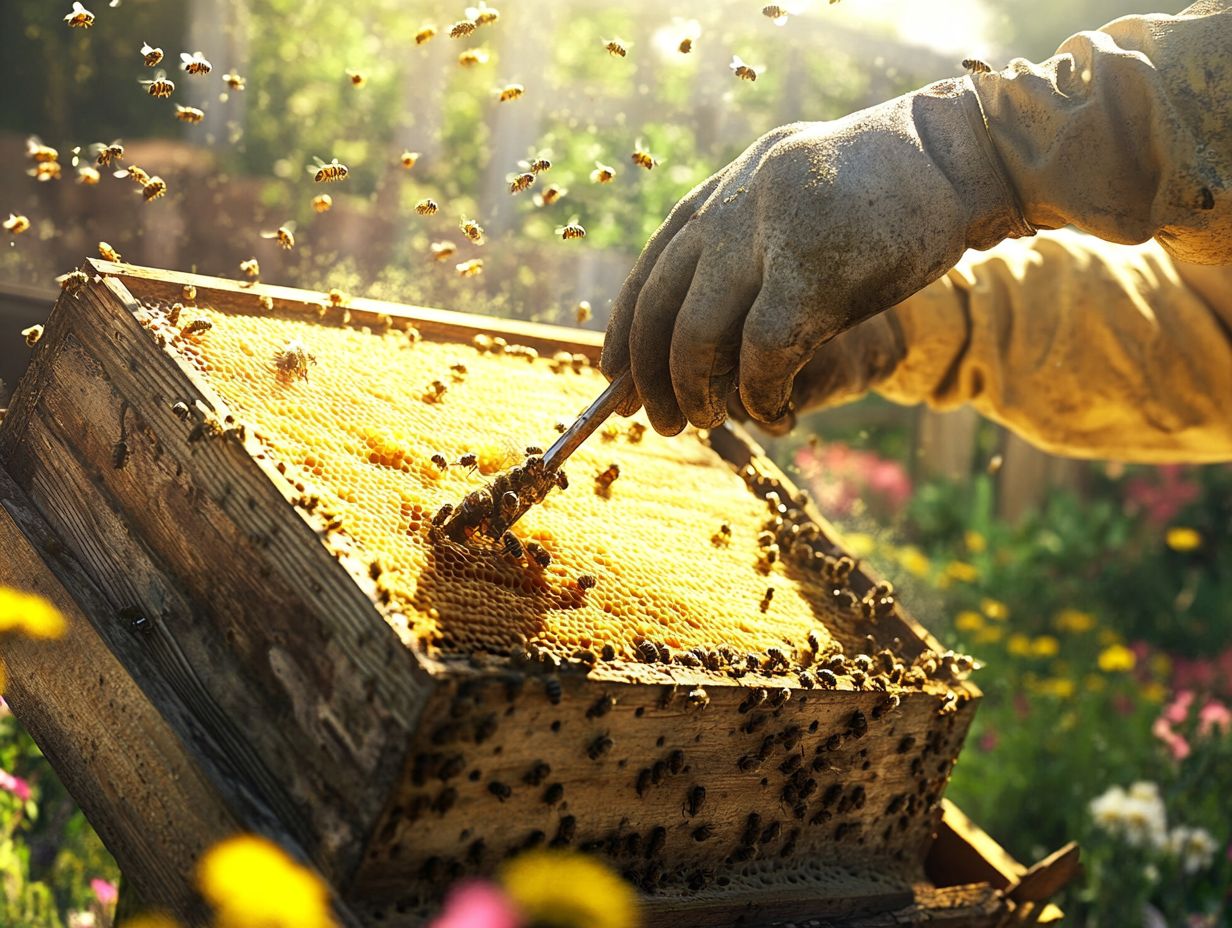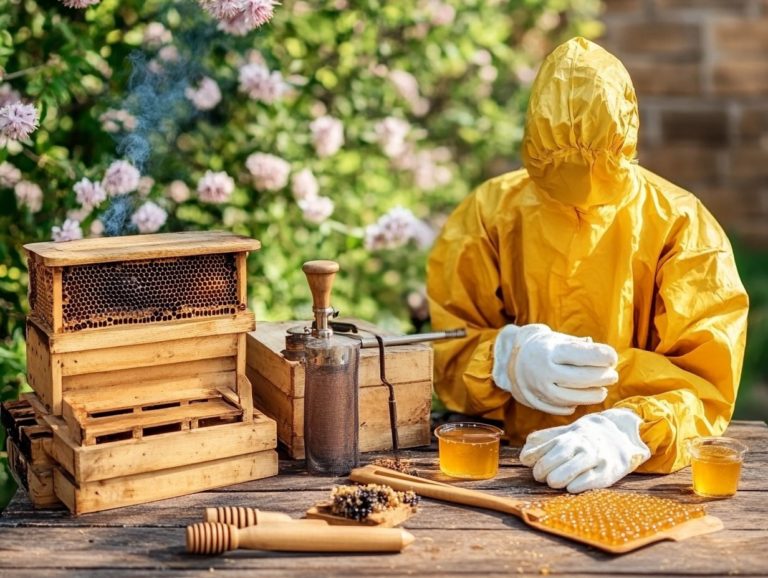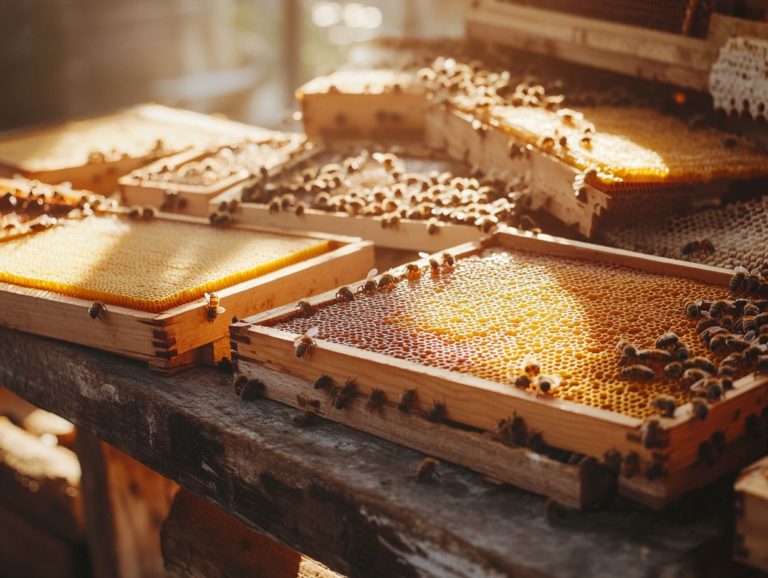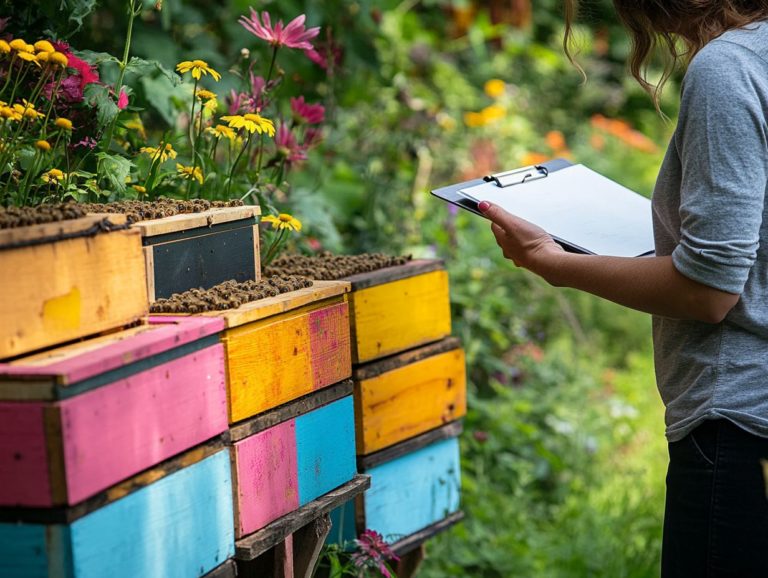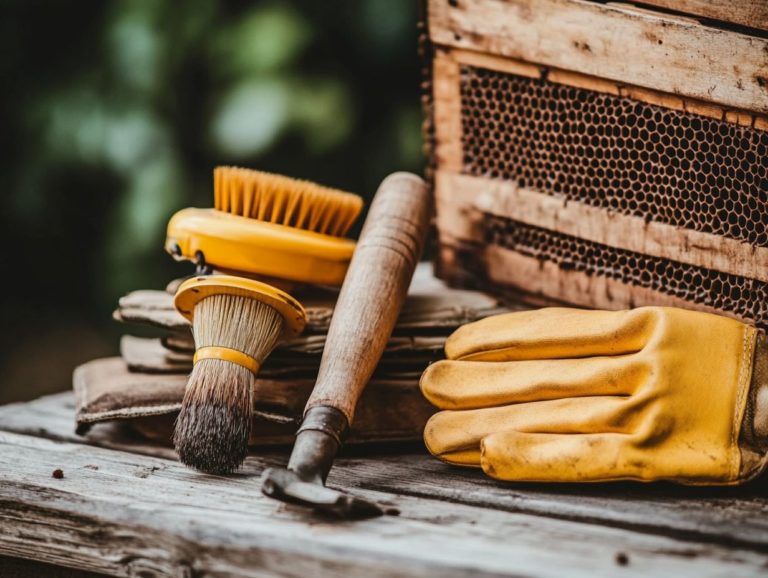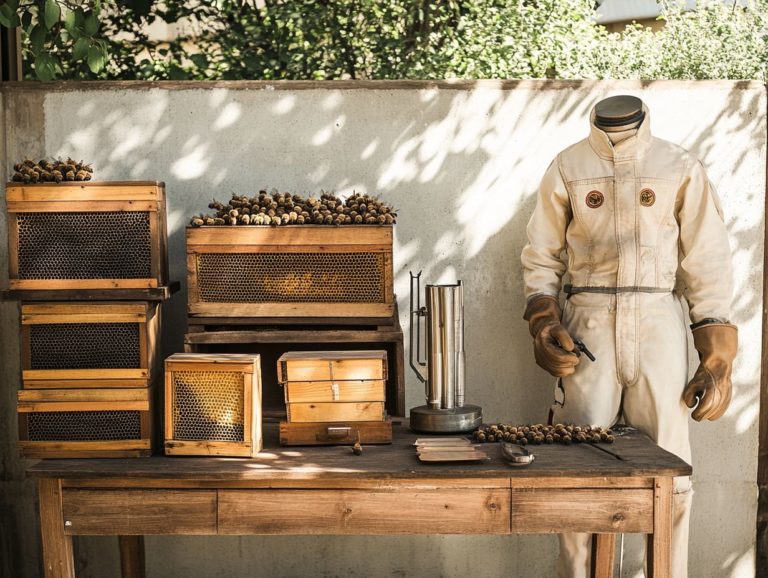How to Use a Hive Tool Efficiently
For beekeepers, a hive tool is an important tool in nurturing a thriving and productive beehive. This versatile instrument streamlines the process of accessing the hive and assists you in various tasks, from lifting frames to scraping away excess wax, while ensuring your bees remain undisturbed during inspections.
In this guide, you will discover the different types of hive tools, their significance, and how to select the perfect one for your unique needs, including essential beekeeping supplies like a beekeeping suit and safety precautions. Whether you’re an experienced beekeeper or just beginning your beekeeping journey, mastering the use of a hive tool can greatly enhance your beekeeping experience.
Contents
Key Takeaways:
- Select the right hive tool based on your needs, material, and size for efficient use.
- Utilize the hive tool for tasks such as opening the hive, lifting frames, removing propolis and wax, and gently managing bees.
- Properly close the hive, as it’s just as important as opening it; use your hive tool efficiently for this task as well.
What is a Hive Tool?
A hive tool is an essential companion for beekeepers, designed to assist in the tasks of hive maintenance and management. It helps with lifting frames, scraping propolis (a resinous substance collected by bees), and conducting thorough hive inspections, making it a vital asset on your beekeeping journey.
Without the right hive tools, managing your colonies and keeping your bees healthy can be challenging. Recognizing the significance of a hive tool can greatly enhance your efficiency, ensuring that both you and your bee colonies flourish.
Why is a Hive Tool Important?
The importance of a hive tool in beekeeping is crucial for maintaining the health and productivity of your bee colonies. It ensures proper hive maintenance and allows you to conduct hive inspections confidently. This enables you to evaluate the well-being of your bees, monitor honey production, and address any issues swiftly.
Using a hive tool enhances your safety during maintenance, protecting both you and your bees while minimizing stress on these essential pollinators. Understanding the value of these tools is crucial for anyone embarking on their beekeeping journey.
What Are the Different Types of Hive Tools?
Understanding the various types of hive tools is essential for beekeepers, as each tool fulfills a distinct role that can improve your hive management. Tools like the standard hive tool, j-hook hive tool, frame lifter hive tool, and scraper hive tool are crafted for specific tasks—from lifting frames to scraping propolis and ensuring effective hive inspections.
Multi-functional hive tools provide the versatility you need for diverse beekeeping tasks, making them essential whether you’re just starting out or have years of experience. Choosing the right hive tool can significantly influence the efficiency and success of your hive inspections and maintenance activities.
1. Standard Hive Tool
The standard hive tool is an essential component of your beekeeping toolkit, providing vital functions for maintaining and inspecting your hives. Crafted from robust materials like stainless steel or high-quality aluminum, this tool withstands outdoor challenges, effectively resisting rust and wear.
Equipped with an ergonomic handle, it offers a secure grip for long working hours. Beyond prying and scraping, the hive tool is crucial for manipulating frames, checking for disease signs, and even splitting hives when necessary.
For novice and seasoned apiarists alike, the standard hive tool emerges as a cornerstone of their beekeeping supplies.
2. J-Hook Hive Tool
The j-hook hive tool is your go-to beekeeping companion. It is expertly crafted for lifting frames and granting effortless access to your hive.
Its distinctive hook shape provides a secure grip on frames, allowing you to handle them with ease while minimizing any disruption to the bees or the hive itself. This is critical for maintaining healthy colonies.
Many beekeepers gravitate toward this j-hook design due to its efficiency, particularly during inspections and honey extractions. Opting for a high-quality j-hook hive tool from reputable suppliers like Dadant & Sons can significantly elevate your beekeeping experience.
By incorporating the j-hook tool into your routine, you can swiftly tackle essential tasks, such as checking for pests or disease—a vital aspect of maintaining a thriving colony.
When compared to standard hive tools, the j-hook offers superior leverage and control. This greatly reduces the likelihood of crushing bees or upsetting the hive’s fragile ecosystem.
Its versatility doesn’t stop at frame lifting; it also excels at prying apart sticky super frames and scraping away excess propolis.
With a design that caters to both novice and seasoned beekeepers, the j-hook hive tool stands as a valuable tool, perfectly suited to streamline your hive maintenance process.
3. Frame Lifter Hive Tool
The frame lifter hive tool is truly a game-changer. It is designed to redefine how you lift frames from the hive, making frame lifting safer and more efficient.
Its ergonomic design makes it effortless for you to handle those heavy frames, dramatically reducing the risk of injury or strain during your hive inspections.
This tool becomes especially invaluable during honey extraction, where juggling multiple frames can feel daunting. By adding a frame lifter to your beekeeping supplies, you elevate your efficiency and safety when working with your bees.
Not only does it feature an ergonomic design, but the frame lifter also has a lightweight yet sturdy construction. This makes it easy to maneuver even during those longer sessions at the hive.
Its unique design enhances your grip, ensuring you can lift and inspect frames with total confidence. This tool also assists you in repositioning frames and managing your hive more effectively.
With this essential equipment in hand, you can streamline your workflow. This enables thorough inspections and maintenance without the usual cumbersome effort.
Whether you’re just starting out or have years of experience under your belt, incorporating this tool into your routine can revolutionize your approach to hive management. This leads to healthier bees and more productive hives.
4. Scraper Hive Tool
The scraper hive tool is a must-have for every beekeeper! It is especially important for keeping your hives pristine by effectively scraping away propolis and wax buildup. This ensures optimal bee behavior.
With its sharp edge, this tool makes it a breeze to remove excess materials, ensuring proper ventilation and hygiene within your hive. By regularly using a scraper hive tool, you can prevent potential issues related to bee behavior, ultimately enhancing the overall health of your colonies.
By keeping your hives free from debris, you create an environment that fosters healthy bee activity and productivity. The scraper hive tool is thoughtfully designed to accommodate various hive configurations, making it both versatile and user-friendly.
Its lightweight structure allows you to maneuver it effortlessly with one hand, making hive maintenance feel less like a chore.
This tool also offers more than just cleaning. A clean hive cultivates a healthier ecosystem for your bees, encouraging natural foraging and reducing stress within the colony. This ultimately contributes to their overall health.
Incorporating this tool into your regular hive inspections can lead to long-term benefits, significantly boosting the success of your beekeeping endeavors.
How to Choose the Right Hive Tool?
Selecting the right hive tool is important for effective hive maintenance. It can greatly enhance your overall beekeeping experience.
Consider your specific tasks, the types of hives you manage, and your comfort with different tools. Each factor influences your choice.
Safety is crucial too. The right tools reduce risks during hive inspections and lifting frames. Understanding these factors helps you make informed decisions.
What Type of Hive Tool Do You Need?
Determining the right type of hive tool is important for managing your beekeeping tasks effectively.
Your tools will directly affect your efficiency and the well-being of your bees. A standard hive tool, with a flat edge, is great for prying apart frames.
A j-hook tool provides leverage needed to extract frames from deeper boxes. A frame lifter makes removing frames easier for smoother inspections.
The scraper hive tool is essential for clearing excess propolis and wax from hive bodies. This ensures optimal conditions for your bees.
Get to know what each tool can do for you. Familiarizing yourself with different tools helps streamline your tasks and enhance your beekeeping operation.
What Material Should the Hive Tool Be Made of?
The material of your hive tool is important for its durability and effectiveness.
Choosing high-grade stainless steel gives you exceptional resistance to rust and corrosion, ensuring longevity. Plastic tools are lightweight but often lack robustness.
The material you choose affects how well the tool interacts with hive frames. This impacts your performance during inspections and maintenance.
Grasping these details helps you select the most suitable tools. This ultimately enhances your efficiency and improves the health of your hives.
What Size and Weight Should the Hive Tool Be?
When selecting a hive tool, consider its size and weight for ease of use.
A well-balanced hive tool should be lightweight yet sturdy enough for hive maintenance tasks. Choosing the right size boosts your maneuverability.
This ensures you can perform inspections and manage frames confidently. The right balance between size and weight contributes to an enjoyable beekeeping experience.
The usability of these tools impacts your workflow, especially during the busy honey harvest season.
A lighter tool eases fatigue and allows for greater precision when handling bees and frames. Ergonomically designed hive tools often have comfortable grips for better control.
Prioritizing the right size and weight in your hive tools increases efficiency and minimizes accident risks. This leads to a smoother beekeeping operation.
How to Use a Hive Tool Efficiently?
Using a hive tool effectively is essential for successful hive management. It directly influences the safety and well-being of you and your bees.
Grasping the correct techniques for opening the hive, lifting frames, scraping propolis, and gently removing bees can enhance your beekeeping experience.
Properly using a hive tool reduces stress on your bee colonies. This ensures smooth honey extraction and hive inspections.
Mastering these skills will elevate your maintenance practices and create a healthier environment for your bees.
1. Opening the Hive
Opening the hive is your first crucial step in any hive inspection. Using a hive tool correctly can streamline this process while ensuring you have safety precautions in place. The hive tool is your trusty companion for prying the lid or cover off the hive, granting you access to the frames and allowing you to inspect the health of the colonies within.
Approach this task with calm and care. Minimize disruption to the bees and foster a peaceful beekeeping environment. By following proper techniques, you can open the hive both efficiently and safely.
To start, gently smoke the entrance before you open the hive. This simple step calms the bees and reduces the chances of them becoming defensive. When you use the hive tool, insert it between the hive cover and the top of the frames at an angle. Apply slow, steady pressure to ease the cover off without any jerky movements that might startle the bees.
Keep your movements slow and deliberate, allowing the bees to acclimate to your presence. Always check for clusters of bees before fully removing any parts of the hive to ensure your inspection causes minimal disturbance.
2. Lifting Frames
Lifting frames from the hive is an essential task in your beekeeping journey. Having the right hive tool at your disposal is key to making the process smooth and efficient. Tools like the frame lifter or standard hive tool enable you to safely extract frames without harming the bees or the comb.
Mastering this technique not only enhances your inspections but also streamlines honey extraction and overall hive maintenance. Efficiency is crucial for preserving the health and productivity of your bee colonies.
As you get started, approach the hive with a calm demeanor. Sudden movements can easily agitate the bees and lead to unwanted stings. Position your hive tool carefully between the frames for a seamless lift. Consider using a bee brush to gently remove any bees clinging to the frames before you lift them. This safeguards the bees and helps maintain the delicate structure of the comb, ensuring it stays intact.
Regularly inspect the hive for signs of disease or pests while lifting frames. This vigilance contributes to the overall health and productivity of your colony.
3. Scraping Propolis and Wax
Scraping propolis and wax from the hive is crucial for enhancing the health of your beekeeping environment. Utilizing a scraper hive tool allows you to efficiently remove excess materials that could obstruct airflow and create unsanitary conditions within the hive.
This practice cultivates a healthier atmosphere for your bees and boosts their productivity and longevity. Regularly clearing away propolis and wax buildup ensures ample space for the queen to lay her eggs and for the bees to store honey and pollen.
Make this task a routine part of your beekeeping. Spotting potential issues early—like pest infestations or diseases—allows for timely interventions.
By maintaining optimal hive conditions through these scraping techniques, you foster a robust and efficient bee colony, leading to increased honey yields and better resilience against environmental stresses.
4. Removing Bees from Frames
Removing bees from frames is a delicate endeavor that demands your understanding of bee behavior and the proper use of a hive tool. This ensures safety for both you and the bees. Using a scraper hive tool allows you to gently dislodge bees without causing harm, thus facilitating thorough inspections and effective hive management.
Master the right techniques for this task to minimize stress for the colonies and maintain a harmonious hive environment.
As you approach this task, stay calm and avoid sudden movements. Bees are adept at sensing agitation. One effective method is to use a gentle brushing motion with a bee brush to encourage them to move away from the frames. Another strategy involves tilting the frame at an angle, prompting the bees to migrate downward, making it easier for you to complete the job without causing alarm.
Prioritize safety by wearing protective gear, such as gloves and a veil. This is crucial for preventing stings and ensuring that both you and the bees remain safe throughout the process.
Now that you know how to successfully open the hive, lift frames, scrape propolis and wax, and remove bees, it’s time to practice and enhance your beekeeping skills!
5. Closing the Hive
Closing the hive is a crucial final step after your inspections and maintenance. This ensures that your bees are safely housed and well-protected. Using a hive tool to carefully replace the lid or cover prevents damage to the hive components and guarantees a tight seal, which is vital for regulating the internal conditions.
Completing this step carefully is essential for safeguarding the health and safety of the bees. It also allows you to finish your inspections with confidence.
It’s important to check for any gaps or misalignments that could invite pests or disrupt the delicate environment within. Keeping the hive in good shape is key to the bees’ health and optimizes their productivity.
Regularly inspecting the hive’s exterior ensures that all entrances are secure and adequately protected from potential predators. By employing these techniques diligently, you’ll create a stable sanctuary for your bees, helping them thrive season after season!
Frequently Asked Questions
How do I properly hold a hive tool?
To use a hive tool efficiently, grip the handle tightly with your dominant hand and hold the other end near the blade with your non-dominant hand. This will give you better control and leverage when using the tool.
What is the best way to remove frames with a hive tool?
To remove frames, insert the blade between the frames and gently lift upward. Be sure to use a prying motion rather than pulling straight out, as this can damage the frames or the hive. Using a spur hive tool can make this process easier and more efficient.
Can I use a hive tool to scrape propolis?
Yes, a hive tool can be very useful for scraping off propolis, a sticky substance made by bees that is used to seal gaps in the hive. The flat edge of the tool is perfect for this task, helping to maintain hive cleanliness.
How can I use a hive tool to inspect my hive?
To inspect your hive, use the sharp end of the hive tool to scrape away any excess wax or propolis that may be blocking your view. You can also use the tool to gently pry open frames and check for signs of disease or pests.
Look out for nectar, as it may indicate the health of your bees.
For further information or guidance on beekeeping, feel free to explore more resources!
Is it necessary to clean my hive tool after every use?
Yes, it’s essential to clean your hive tool after each use. This simple step prevents the spread of diseases and pests.
Just wipe it down with a damp cloth and let it dry before storing. Regular maintenance will extend the lifespan of your tools.
What should I do if my hive tool gets stuck?
If your hive tool gets stuck, try tapping the handle gently with a hammer. If that doesn’t help, pour hot water over the stuck area to loosen any sticky substance.
Check your frame lifting technique to avoid getting your tool stuck in the future.


